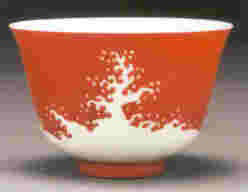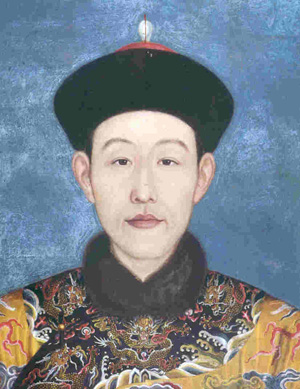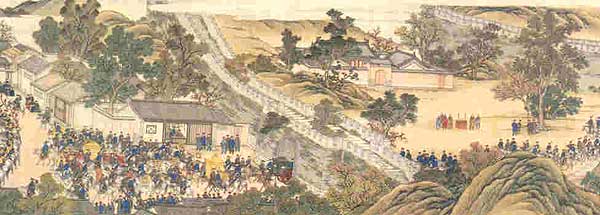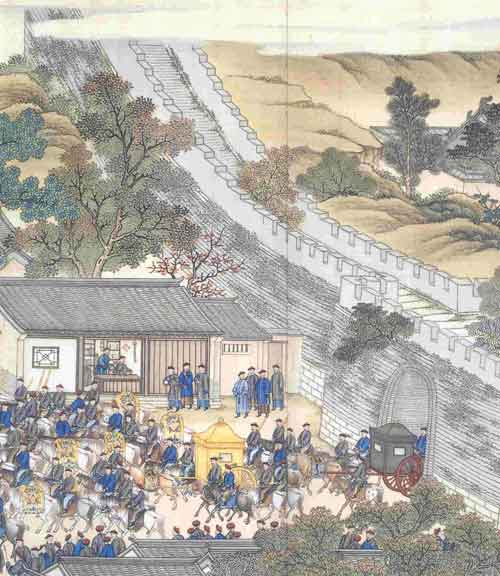|
|||||||||
|
HERITAGE AND ARCHAEOLOGICAL NEWS BRIEFSEXHIBITION REVIEWLES TRÈS RICHES HEURES DE LA COUR DE CHINE, CHEF-D'ŒUVRES DE LA PEINTURE IMPÉRIALE DES QING, 1662-1796(A Book of Hours of the Chinese Court, masterpieces of imperial painting from the Qing, 1662-1796)—Guimet Museum, Paris, 26 April-4 September 2006. Les Très Riches Heures de la Cour de Chine, chef-d'œuvres de la peinture impériale des Qing, 1662-1796, edited by Marie-Catherine Rey and Jacques Giès, Paris: Éditions de la Réunion des Musées Nationaux, 2006, 237pp. I had given up on trying to see paintings on Chinese themes made by Jesuits, having had too many near misses in the past. Once, seeking the 'One hundred horses' (Baijun tu, at Taipei's National Palace Museum, painted by the Qing imperial court painter and Jesuit brother, Giuseppe Castiglione (1688-1766), I got to the space on the wall where it should have been, only to read that these horses had bolted, and were meandering around the United States on a cultural exchange. Another time, closer to home, I sought out 'River and sky shrouded in the mist of sunset rain' (sometimes known as 'Landscape with willows'—Jiangtian muyu tu), the only Wu Li painting held by the Art Gallery of New South Wales, in Sydney, to find that it was not on display at that time. Wu Li was not only one of the first Chinese Catholic priests (he was a member of the Society of Jesus, the Jesuits), ordained in 1688, but he was also a noted painter of the late Ming and early Qing period.  Fig. 1 'Bowl decorated with wave pattern' (Haibowen xiaowan), catalogue p.89, pl.28 So, it was a surprise to be in the Guimet Museum in Paris recently viewing some stunning pieces from this museum's permanent collection. Entitled 'A Book of Hours of the Chinese Court, masterpieces of imperial painting from the Qing, 1662-1796' (hereafter 'Book of Hours'), the exhibition featured nine scrolls painted by imperial court artists, including several by Castiglione, as well as album sheets, paintings on fans, engravings, an album of imperial seals, work dealing with perspective and pieces from the Grandidier collection of porcelains. (Fig. 1) Of these scrolls more in a moment, but first a word on the genesis of this exhibition. In many ways, the exhibition was presented as the French addition to the number of international exhibitions of hitherto rarely seen works from the Palace Museum, Beijing, that have been held in Chicago, Dallas and London over the past few years. The first of these was the 'Splendors of China's Forbidden City: The Glorious Reign of Emperor Qianlong' at the Field Museum of Natural History in Chicago (12 March-12 September 2004) and then the Dallas Museum of Art (21 November 2004-29 May 2005), the second being 'China: The Three Emperors, 1662-1795', at the Royal Academy of Arts in London (12 November 2005-17 April 2006). 'A Book of Hours' was a significant part of this wave of exhibited Chinese imperial art. One major difference, however, between the Anglo-American exhibitions and the one at the Musée National des Arts Asiatiques-Guimet, to give the museum its proper name, was that almost all of the work in the French exhibition came from that museum's own collections. The ability of this French museum to stage such an exhibition practically on its own, containing over one hundred works from the Ming and Qing dynasties, some of them never before exhibited in Paris, requires some few words of explanation. France's rich cultural exchange with China can be said to have begun, in a formal way, when Louis XIV sent as his 'Royal Mathematicians' a group of six French Jesuit priests, well trained as scientists and mathematicians, to that country. They left from Brest on the 3 March 1685 and arrived at Ningbo on the east China coast on 23 July 1687. In so doing they broke the traditional control over the entry of foreigners to China held by the Portuguese, referred to as the padroado in Portuguese. Such control was the 'right' of the Portuguese as a result of the carve-up of the world into two parts by the 1494 Convention of Tordesillas, with the Spanish holding a similar right (patronato) in the 'New World'. Furthermore, these French Jesuits also initiated a centuries-long fascination with China, a fascination that continues apace today and which has resulted in French Sinology holding an exalted place in the annals of China studies. In most major areas of study about China, from geography to Buddhology, French academics have made significant and at times singular contributions. French religious figures, including Jesuits, can also be found in this list of academic achievement, especially in the 18th and 19th centuries, in equally diverse fields. Yet, for both the secular and the religious French Sinologist, often these contributions have also had, as one goal amongst many, the advancement of French interests. The porcelain collection now housed in the Guimet Museum, for example, was started in the late 19th century in deliberate response to the belated realisation that the institutions of other nations were better resourced than their French counterparts. It has been suggested that the recognition that many of these other institutions were 'Anglo-Saxon' ones, was somewhat galling (see Mael Bellec's essay, 'La collection Ernest Grandidier', p. 99 of the exhibition catalogue). The splendour of the exhibition 'A Book of Hours' can thus be traced in the main to initiatives of two French philanthropists, Emile Guimet (1836-1918) and Ernest Grandidier (1833-1912). Working independently of each other, they amassed sizable collections of paintings, porcelains and other cultural objects, determined they would become valuable additions to France's patrimony. As noted previously, Grandidier concentrated on Chinese porcelains, whilst Guimet initially wished to open a museum that was devoted to 'the religions of Ancient Egypt, Classical Antiquity, and Asia'. Over time, however, he increasingly concentrated on material that was specifically concerned with Asian civilisations. According to the official history of the Guimet Museum, although Emile Guimet first built a museum in Lyon, he soon moved this to Paris, where the new structure was inaugurated in 1889. These collections of Asian works continued to grow, both in the numbers of exhibits and in their prestige as collections.  Fig. 2 'Portrait of Emperor Qianlong' (Qianlong xiaoxiang tu) by Lang Shining (Giuseppe Castiglione), catalogue p.97, pl.41 Ernest Grandidier donated a large portion of his collection of porcelains to the Louvre Museum in 1894, where they continued to be cared for and added to over the years by numerous other collectors and curators. Like the priceless stained glass windows of Chartres Cathedral, saved from destruction during WWII by the foresight of the then prefect of Chartres, Jean Moulin (who stored them in disused mine shafts), these Chinese porcelains—the Grandidier collection—escaped theft and the perils of war by being hidden for the duration of the conflict. After Grandidier's porcelains were removed from their hiding places in the cellars of Chateau Valençay in the Indre Valley, following the hostilities, they were then returned to Paris. In the major reorganization of French museum holdings immediately after WWII, the Grandidier Collection found its permanent home at the Guimet Museum. In return, the Egyptian pieces held by this museum were transferred to the Louvre, accentuating the Guimet Museum's role as the chief custodian of Asian holdings in France. (Fig. 2) A massive building renovation project was initiated in 1996, undertaken by the father-and-son French architectural team of Henri and Bruno Gaudin. Specialising in the use of natural light, and adept at breathing new life into old forms, having completed a highly praised renovation of the Charlety Stadium in 1994, the Gaudins completed their task in 2001. The result is worthy of the lofty aims of both Guimet and Grandidier, being a building that is as charming as it is impressive, light and spacious, and capable of evoking pride and joy. [For a virtual tour of the Museum go to:
http://www.museeguimet.fr/homes/home_id20638_u1l2.htm
and for some photographs of the museum go to: It was to mark the fifth anniversary of the completion of this renovation that the directors of the Guimet decided to draw upon the wealth of their imperial Chinese holdings. As was noted earlier, some of the works selected had not previously been seen in public. The result was an exhibition that was as sumptuous as it was splendid. 'A Book of Hours' was also very successful, being extended beyond its initial closure of 24 July 2006. Again this was made possible because the majority of works are owned by the Guimet Museum, or by other French museums and libraries, including the National Library of France and the Forney Library. The show also features two other works by Castiglione on loan from the National Museum of the Palace of Taipei, namely the painting 'The Empress watching over sericulture rites' (Qincan tu, disi juan) and a vertical scroll painting simply entitled 'Scenery' (Shanshui tu).  Fig. 3 'The Mulan Hunt' (Mulan tu, di yi juan), catalogue p.195, pl.101 The lavish catalogue that accompanies the exhibition was edited by Marie-Catherine Rey, curator of the museum, and Jacques Giès, chief curator of the museum's Chinese and Central Asian collections. This work contains a wealth of accompanying information, as well as fine and generous reproductions of the pieces on display. In keeping with the Guimet Museum's commitment to education programmes, several short essays in the catalogue are pedagogical in style, for instance the article by the Sinologist Wang Chia-yu on imperial seals of the Qing dynasty (pp. 113-14), and another by Camille Schmitt, an expert restorer of graphic art works who writes about mounting techniques used on the imperial scroll paintings (pp. 115-17). There are also a series of shorter pieces by Mael Bellec concerning the provenance of the museum's collections, the artistic representation of examples of good governance and the content of the four Castiglione scrolls known as 'The Mulan hunt' (Mulan tu). (Fig. 3) These four horizontal scrolls, 'The Journey' (Mulan tu, di yi juan), 'The Encampment' (Mulan tu, di er juan), 'The Banquet' (Mulan tu, di san tu) and 'The Encirclement' (Mulan tu, di si juan), are each slightly more than fifty centimetres in width, and are each an impressive sixteen metres long. The catalogue has wisely and generously reprinted each of these scrolls, boths as four double page spreads (cat. pages 101, 102, 106, 107), where each scroll has been divided into four sections, and then, on other pages, individual reproductions of particular sections of each scroll. So it is that for the portions of the scroll entitled in the exhibition 'The Journey', for instance (pp.194-99), in addition to being able to have a sense of the overall scroll, one can also view a magnified image of the Emperor Qianlong's entourage passing through a section of the Great Wall. (Fig. 4) This image is particularly topical for Australians, in so far as Sydney's Powerhouse Museum has just opened an exhibition entitled The Great Wall of China: dynasties, dragons and warriors (http://www.powerhousemuseum.com/exhibitions/great_wall.asp) mentioned in the last issue of the present publication (China Heritage Quarterly No. 6, June 2006).  Fig. 4 Detail, catalogue pp.196,197 These four scrolls were produced by painters at Qianlong's court, although it seems likely that Castilgione completed the majority of the figures, and various court artists, including Jin Kun, Ding Guanpeng, Ding Guanhe, Cheng Liang, Wu Gui, She Xizhang, Cheng Zhidao, Li Huilin, Lu Zhan and Chen Yongjie painted much of the scenery. The four scrolls have an immense amount of detail, so much so that not only would it have been a massive task for any one individual to paint them in their entirety but it also takes much lengthy and committed viewing for an observer to do justice to the scenes so depicted. Each of these scrolls, which are to be viewed right to left, allow the viewer to follow a moment in time, be this the quiet of evening at Qianlong's encampment, or the panicked flight of deer in the face of the hunting Qianlong (a close-up of which also appears as the cover image of the exhibition catalogue). The length of the scrolls, however, means that the observer is effectively viewing the one moment as it was being lived by the various people in the painting. Thus, even as Qianlong draws his bow to shoot at his quarry, watched by his troops, others of the entourage are watering the horses, packing carts or even just enjoying a moment of rest. The viewer, walking back and forth along the length of the scrolls, can make these four moments stretch into a very rich hour. Marie-Catherine Rey, the curator of the exhibition, has also written essays for the catalogue on Chinese painting techniques, Castiglione's work for Qianlong and the 'Four Wangs' school of the late Ming and early Qing. I have declared my Jesuit bias already but I do think there was a missed opportunity here in not mentioning as part of this school, as scholars usually do, Yun Shouping (1633-1690) and the Jesuit priest-painter Wu Li (1632-1718). Both of these artists are considered to be part of the 'Four Wangs', a group also known as 'the Six Masters of the Early Qing'. Given the preponderance of Jesuit work in this exhibition, and the influence of the Jesuits employed as artists at the imperial court, many of whom were French, this struck me as surprisingly reticent. There is also a lengthier piece by Jacques Giès on theories of perspective contained in Nian Xiyao's work (pp.13-43). Wang Chia-yu also contributed an essay entitled 'The Manchu Dynasty: a Chinese court' (pp. 101-111). These too are well illustrated and informative. The major contribution of this catalogue, however, is the manner in which it enables those who missed the exhibition to gain some sense of the grandeur of the Guimet's collection. The exhibition and the accompanying catalogue are a deliberate allusion to the magnificently illustrated medieval book of prayer, Les Très Riches Heures (Books of Hours were collections of liturgical prayers and readings for different times of the day), commissioned by Jean, Duc de Berry, and completed sometime before 1416. The Duc de Berry's version of the book contained exquisitely painted miniatures that enticed the viewer into rapturous contemplation. In the same way, the Guimet Museum hoped that visitors by attending this exhibition and walking slowly along the length of the nine scrolls, nose barely above the glass cabinets, or paused in front of fragile treasures from the Grandidier collection, or viewing the numerous other pieces from its rich stores, would feel a similar sense of marvellous delight. In this regard, for this viewer at least, the Guimet Museum more than fulfilled its goals. The exhibition and the catalogue are very rich offerings indeed. [Jeremy Clarke SJ] |